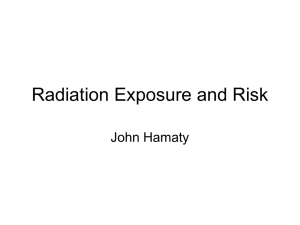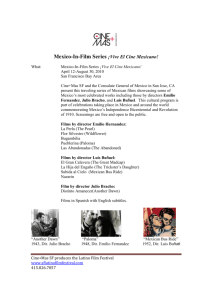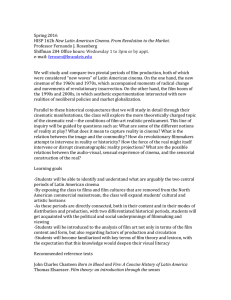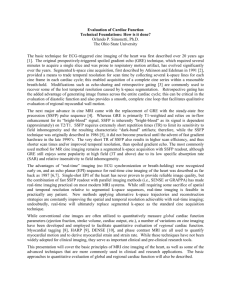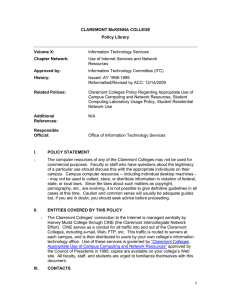EVALUATION OF RADIATION EXPOSURE LEVELS IN CINE CARDIAC
advertisement
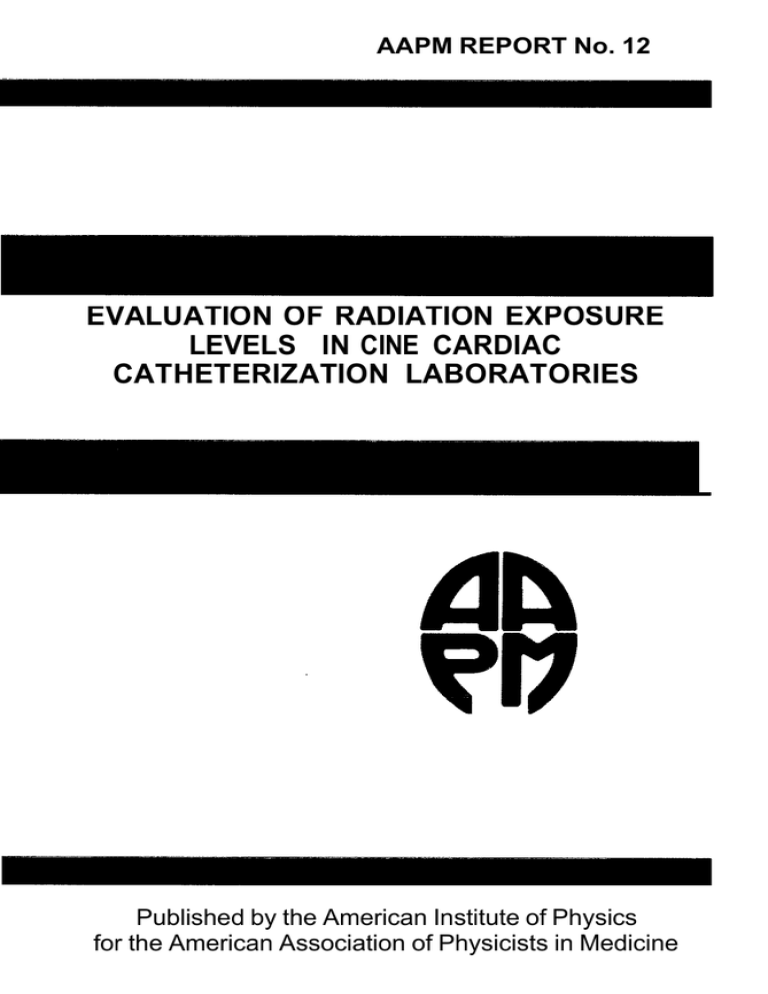
AAPM REPORT No. 12 EVALUATION OF RADIATION EXPOSURE LEVELS IN CINE CARDIAC CATHETERIZATION LABORATORIES Published by the American Institute of Physics for the American Association of Physicists in Medicine AAPM REPORT No. 12 EVALUATION OF RADIATION EXPOSURE LEVELS IN CINE CARDIAC CATHETERIZATION LABORATORIES A Report of the Cine Task Force Diagnostic Radiology Committee American Association of Physicists in Medicine Stephen Balter Cari Borras Pei-Jan Paul Lin, Co-Chairman Robert J. Moore William E. Moore Perry Sprawls, Jr., Chairman January 1984 Published for the American Association of Physicists in Medicine by the American Institute of Physics Further copies of this report may be obtained from Executive Secretary American Association of Physicists in Medicine 335 E. 45 Street New York, NY 10017 Library of Congress Catalog Card Number: 84-70135 International Standard Book Number: 0-88318-439-7 International Standard Serial Number: 0271-7344 Copyright © 1984 by the American Association of Physicists in Medicine All rights reserved. No part of this publication may be reproduced, stored in a retrieval system, or transmitted in any form or by any means (electronic, mechanical, photocopying, recording, or otherwise) without the prior written permission of the publisher. Published by the American Institute of Physics, Inc. 335 East 45 Street, New York, NY 10017 Printed in the United States of America Table of Contents Table of Contents Page 1. Introduction------------------------------------ 1 II. System Description------------------------------ 2 II-A. Cine Camera---------------------------- 2 II-B. The Automatic Exposure Control System-- 2 II-C. Cine System Parameters----------------- 4 II-E. Description of Cine AEC System--------- 4 III. Radiation Exposure------------------------------ 8 III-A. Patient Exposure----------------------- 9 III-B. Personnel Exposure---------------------18 III-C. Summary--------------------------------11 IV. Image Intensifier Input Exposure Sensitivity Measurement-------- -----------------------------14 IV-A. Instrumentation----- -------------------14 IV-A-l. Ionization Chamber-------------l4 IV-A-2. Absorber-----------------------14 IV-B. Measurement Procedure------------------l5 IV-B-l. Anti-scatter Grid--------------15 IV-B-2. Focal Spot Image Intensifier Tube Distance-----------------------l5 IV-B-3. Field Size---------------------l6 IV-B-4. X-ray Tube Potential-----------l6 IV-B-5. Measurement--------------------l7 IV-P-6. Correction Factors-------------l7 V. Fluoroscopic Input Exposure Rate Sensitivity Measurement------------------------------------l7 VI. Half-Value Thickness Measurement---------------l8 VII. Estimation of Patient and Personnel Exposures--19 VII-A. Instrumentation-------------------------l9 VII-B. Preparation-----------------------------20 VII-C. Phantom---------------------------------20 VII-D. Measurement Procedure-------------------20 VIII. IX. Measurement Examples-----------------------------21 Conclusion-------------------------------------25 References-------------------------------------27 I. INTRODUCTION Cinefluorographic examinations are widely employed for cardiovascular examinations in which it is necessary to document dynamic physiological functions such as heart function and blood flow. Although it is a useful diagnostic tool, a cine examination has the potential of producing relatively high radiation exposure levels to both the patient and the medical personnel conducting the examination. The basic reason for the relatively high exposure values is that the examination consists of a large number of high quality cine images which are obtained with high radiation exposures. An additional relatively factor which contributes to the exposure to the medical personnel is that in many cine examinations, it is difficult to shield the scattered radiation effectively in some of the x-ray beam projections. The radiological physicist is often called on to evaluate specific cine systems with respect to patient The purpose of this report is and personnel exposures. to describe a procedure for conducting such an evaluation. By using a standardized procedure it then becomes possible to intercompare various systems and to systems to accepted norms and specific compare standards" 1,&2. Excessive levels of radiation in the cardiac catheterization procedure, both to the patient and to the laboratory environment are often traced to improper adjustment and/or use of the following major factors: (1) (2) the automatic cine film the cine imaging chain, processor, (3) selection of cine fluorographic "ON" time, either (4) techniques, excessive beam fluoroscopy or cine filming, and (5) improper room layout. The first factor, the cine imaging chain, can be the image evaluated through the measurement of (IIIES). intensifier input exposure sensitivity Establishment of a standard measurement protocol for IIIES is one of the main efforts in this report. Quality assurance monitoring of the cine automatic film processor cine film reduces many problems associated with fluorographic processing. Selection of the cine techniques should be reviewed from time to time to assure optimized utilization of the equipment capability: for example, use of lower filming rate, or selection of a higher speed cine film, etc. may result in lower x-ray technique factors for cine filming and reduce scattered radiation from the patient. However, clinical conditions may limit the range of selections of cine fluorographic techniques in favor of the image quality required. This report begins with a general description of 1 cine systems. This is followed with a discussion of the factors which have an effect on both patient and personnel The report continues with a exposures. description of the instrumentation and procedures for conducting an evaluation of the IIIES, the patient exposure, and the personnel exposure. The interpretation of the evaluation results is then discussed following each physical parameter of interest. II. SYSTEM DESCRIPTION 3 The components comprising a basic cine system are depicted in Figure 1. Most of the components such as the x-ray tube, image intensifier tube and power supply are similar to the components of a conventional fluoroscopic system. A possible exception is a higher heat storage capacity x-ray tube. Two components which are not found in conventional fluoroscopic systems are the cine camera and the automatic exposure control (AEC) circuitry for cine fluorography. A bi-plane cine imaging configuration utilizing a suspended C-arm or a ceiling suspended lateral plane cine imaging system, for example, may be found in the cardiac catheterization laboratories in addition to the basic single plane system. Although the lateral plane increases the and electronical mechanical complexity of the equipment, it is basically a duplication of the single plane cine system in terms of the operation. II-A. Cine Camera In the cine system the image is recorded on 35 mm film by means of a motor driven camera. In a typical system, the x-ray beam is pulsed so that the production of x-radiation is synchronized with the cine camera shutter movements. The camera speed is selected by the operator, and the framing rate is in the range of 15-90 frames per second depending on the type Of examinations and patients, i.e., adult or pediatric. The amount of light required is determined by the sensitivity (speed) of the cine film and the cine camera lens f-stop (the aperture size). -The focal length of the camera lens determines the degree of framing or matching between the image presented at the output phosphor of the image intensifier and the film area1,2. II-B. The Automatic Exposure Control (AEC) System The designed AEC circuitry of typical cine systems is to maintain a constant light level at the image 2 intensifier output phosphor during cine filming. The basic operational purpose of the cine AEC circuitry is, therefore, similar to that of the photofluorographic spot film camera and radiographic AEC devices. The complexity and sophistication of the cine AEC systems is somewhat greater and deserves careful study. Because of the generator designs and the method of achieving the constant light level at the output phosphor of an image intensifier, the measurement procedure may have to be tailored to each specific type of equipment. This report attempts to encompass all possible cine AEC logics by describing the cine system parameters that must he taken into account. Its purpose is to generate a standard protocol that can be applied to most cine imaging systems. Figure 1. Schematic Illustration of A Cine Fluorographic Imaging System. 3 II-C. Cine System Parameters The complexity of the cine AEC system is primarily due to the number of variables and/or parameters involved in the cine filming. A change in any of the parameters listed in Table I will alter the light output of the and therefore results in a difference image intensifier, in the cine film exposure. A typical cine system equipped with an AEC device utilizes one or two of the cine technique parameters to attain the constant light output from the image intensifier. The commonly employed parameters are: (a) the x-ray tube potential, (b) the x-ray tube current, or (c) the cine pulse width. Other parameters include: (d) cine filming rate, (e) focal spot size, and (f) cine run time may be considered secondary parameters and are often preset or pre-determined. TABLE I. CINE PARAMETERS -------------------------------------------------Physical Typical Range Parameters in Clinical Case --------------------------------------------------60 - 120 kVp (a) X-ray Tube Potential l00 - 800 mA (b) X-ray Tube Current 1 - 5 msec (c) Cine Pulse Width (d) Cine Filming Rate 15 - 90 frames/sec 0.3 mm - 1.2 mm (e) Focal Spot Size (10 kW - 100 kW) (Power Rating) (f) Cine Run Time * 8, 10, 12, 15 seconds 6"-14" (12 cm - 35 cm) (g) Image Intensifier Mode (single or multi modes) 35 mm (16 mm) (h) Cine Film Size ** --------------------------------------------------Item *For some special applications (such as for speech therapy and research ) a cine run time of 120 seconds may be used, but is not applicable for cardiac catheterization. **Practically speaking, all cardiac catheterization studies are now recorded with 35 mm cine cameras. II-D. Description of Cine AEC System The circuitry utilized in the AEC system varies with the manufacturer and the particular models of generators. A schematic block diagram of a typical cine AEC system 4 utilizing the x-ray tube potential as the principal variable is depicted in Figure 2. It should be noted that in many cases only one of the parameters in BLOCK A is employed as the principal variable of the AEC system. Figure 2. Schematic Block Diagram of Cine Automatic Exposure Control System. Adapted from P.P. Lin, "Acceptance Testing of Cine Imaging Systems for Cardiac Catheterization Laboratories," in AAPM Proceedings Series No. 1, Acceptance Testing of Radiological Imaging Equipment, Ref. # 3. 5 Figure 2 is divided in three columns: the hardware on the left, the electronic and the electro-mechanical controls in the center, and the user selectors on the BLOCK A contains the microprocessors and/or the right. programing boards which interface the selected factors in the right column with the respective electro-mechanical circuits in the center column. Let us follow the sequence of setting up the cine filming technique factors for an adult patient undergoing a cardiac catheterization examination: CINE FILMING SELECTOR: set to 30 frames/sec. (1) The CINE CAMERA CONTROL AND SYNCHRONIZATION stand ready for cine filming and the actual cine filming rate along with the synchronization pulses are sent to BLOCK A for timing adjustments of x-ray pulses. The cine filming rate will significantly affect the total heat units to be stored at the anode, and hence the selected cine filming rate information is fed to BLOCK B for pre-exposure calculations. The FOCAL SPOT SIZE may also be selected with (2) pushbutton as the cine filming rate same the selector. The power rating of the focal spot size determines the instantaneous heat loading allowable to the anode, therefore, this information is fed to the kVp-CONTROL UNIT, and the mA-CONTROL UNIT in BLOCK A as well as the POWER RATING CHECK in BLOCK B. Let us assume that the large focal spot size is selected and is rated at 1.2 mm nominal and 100 kW. The interface between BLOCK A and BLOCK B will become apparent when the cine exposure is made. The PULSE WIDTH SELECTOR determines the cine (3) pulse width to be employed for each cine frame exposure. The allowable range of pulse width is time required for proper film limited by the transport in the cine camera and the cine filming rate. With the cine filming rate selected at 30 frames/sec, the cine pulse width can be as long as 5 msec/pulse. The cine pulse width thus selected is then presented to the PULSE WIDTH CONTROL UNIT in BLOCK A and to BLOCK B, as the pulse width will also affect the total heat units to be accumulated in the anode. A modest selection of CINE RUN TIME choices (4) are normally set by the installation engineer for the particular facility to meet the user's application requirements. (Usually this factor is not available for selection by users at the control panel.) The 6 cine run time is most often set at 10 seconds. At the end of the cine run time of 10 to 12 sec., a warning buzzer is activated and the operator is then given another few seconds before the generator is automatically turned off to protect the x-ray tube. BLOCK A is the heart of the cine AEC system. Prior to initiation of a cine run, let's assume that (a) the kVp-CONTROL UNIT drives the tube potential circuit for cine filming to the lowest potential setting of 60 kVp, and (b) the mA-CONTROL UNIT drives the tube current circuit for the cine filming to the highest current setting of 600 mA. The PULSE WIDTH CONTROL stands ready to provide 5 msec pulses as selected. The optical sensor may be a small prism or a mirror guiding the light to a photomultiplier (some cine systems utilize the TV camera in place of the optical sensor). The prism is usually designed that it looks at the central 40 % to 60 % of the output phosphor. The signal from the optical sensor is amplified at the CINE AEC AMPLIFIER and fed to the SIGNAL COMPARATOR. The SIGNAL COMPARATOR receives the signal from the REFERENCE VOLTAGE source and compares the signal voltage from the CINE AEC AMPLIFIER, and subsequently sends out a signal to activate BLOCK A in accordance with the brightness presented to the optical sensor. Let's assume that the brightness is too low for proper cine film exposure and requires a higher x-ray tube potential of 68 kVp. The kVp-CONTROL UNIT activates the generator to increase the tube potential, and the AEC system may reach a stable state if the tube current rating allows 600 mA for cine filming. As the x-ray tube potential is increased, the POWER RATING CHECK circuit maintains monitoring of the techniques and will activate the mA-CONTROL UNIT to decrease the tube current to 400 mA. Meanwhile the optical sensor sends another signal out to increase the tube potential again because the the brightness at phosphor may have been output acceptable at 68 kVp, 600 mA settings but is not sufficient at 68 kVp, 400 mA settings due to decreased tube current. The same process repeats itself and may reach the final steady state at 72 kVp tube potential with 350 mA tube current. The description given above is that of an automatic iso-watt cine AEC system. Replacing the mA-CONTROL UNIT with a manual tube current selector, the cine AEC system described here becomes that of an "automatic kVp" cine AEC system with constant tube current during cine filming. Replacement of the kVp-CONTROL UNIT with a manual tube potential selector yields an “automatic mA" cine AEC system. Both tube potential and tube current may be 7 manually selected and the exposure time (the pulse width) may be automatically varied. This type of cine AEC system is very simple in its design concept, and is called "automatic pulse width" cine AEC system. If the electronics are fast enough, this type of control resembles a radiographic phototiming system, i.e., if one considers the image intensifier and the optical sensor together as the phototube, and each cine frame as the single radiographic exposure. For each of these types of cine AEC systems, a minor change is required in Figure 2 in accordance with its operational logic. For certain sophisticated AEC systems, additional features are provided, such as (a) automatic optimum tube potential search logic, (b) reduced x-ray tube loading during automatic search of the tube potential, etc. III. RADIATION EXPOSURE In a typical cardiac catheterization laboratory, the physical factors which are of primary interest include, the cine film image quality and the radiation exposure to the patient and the personnel conducting the examination. The radiation exposure values are affected by a number of parameters such as the geometry employed, the radiation exposure required to expose the cine film, etc. There is one equipment setting that affects radiation levels as well as the image quality experienced with the cine imaging systems. This parameter is the image intensifier input exposure sensitivity (IIIES). The IIIES, in turn, is determined by a number of factors: (1) Cine Film Sensitivity (film speed): can be processing dependent. (2) The f-stop setting of the Cine Camera Lens. (3) The Image Intensifier Conversion Factor, and Quantum Detection Efficiency (QDE); aging tendency is a slow (years) process. (4) Light Transmission of the Optical Distributor and Lens System is affected by dirt collection. In principle, the IIIES can be adjusted during the initial calibration of the imaging chain to any value within the equipment capabilities. However, the value of IIIES which is selected should represents a reasonable compromise between the quantum noise and the patient exposure. During the initial calibration of the cine imaging 8 chain, the IIIES is obtained typically at 80 kVp tube potential and adjusted to 10-20 µR/frame for 9" mode and 20-30 µR/frame for 6" mode operation of the image intensifier. It is also assumed that the developed cine projected at a standard display rate of 24 film will be 1&3 frames/sec for normal viewing. The IIIES level adjustment is attained through the cine AEC sensitivity control circuitry. Therefore, when evaluating cine systems with respect to either patient or personnel exposure, it is highly desirable to determine the IIIES at which the system is operating. A procedure for making this determination is described in Section IV of this report. A concept parallel to that of IIIES is the fluoroscopic input exposure rate sensitivity (FIERs). The FIERS is a s s o c i a t e d the fluoroscopic operation of the same cine imaging system, and the sensitivity is adjustable via the f-stop of the television camera lens, the television camera target voltage, and the automatic brightness control (ABC) for fluoroscopy. Typically, the FIERS is set to 40-50 uR/sec (2.4-3.0 mR/min) for 9" mode and 80-100 uR/sec (4.8-6.0 mR/min) for 6" mode operation of the image intensifier 4. III-A. Patient Exposure The total amount of radiation received by the patient undergoing a cardiac catheterization examination is accumulated from the fluoroscopic exposure during the catheterization and the subsequent cine filming. The radiation exposure arising from the fluoroscopic procedure is proportional to the field size selected, and "ON" time and the average the total fluoroscopic radiation output at the entrance site. A simplified method to estimate the patient exposure, due to the fluoroscopy, can be calculated from the entrance skin exposure rate (typically, l-5 R/min) for an average size patient multiplied by the total fluoroscopic "ON" time (typically 10 minutes to 30 minutes). This simplified approach assumes that the radiation beam is always incident on the same site, and thus overestimates the actual dose to any one site, i.e., patient exposure per fluoroscopic/cine view (PA, LAO, RAO, LL, etc.) The patient exposure due to the cine filming exposures is largely dependent on the total number of cine frames taken. The patient exposure due to the cine filming is minimized by selecting the lowest filming rate which adequately images the dynamic aspects of the examination. If the cine patient exposure/frame is known (typically 10-25 mR/frame)5 for each cine view, the cine patient exposure is simply proportional to the cine 9 patient exposure/frame (for that cine view) times the total number of cine frames taken for the corresponding cine view. Typically 300 frames to 1200 frames may be taken for one complete examination consisting of few different cine views. The patient exposure of a given cine system may he altered and affected by (1) the filtration provided in the primary beam path, and (2) the anti-scatter grid attached to the input surface of the image intensifier housing. Therefore, in the evaluation and estimation of the radiation patient exposure, quality in beam Half-value Thickness (HVT) and the anti-scatter grid employed for the cine imaging chain should be considered. III-B. Personnel Exposure The radiation exposure to personnel conducting a cine examination is produced by the radiation scattered from the patient's body and by the leakage radiation from the x-ray tube. For a given situation the scatter to a specific point is approximately proportional to the patient and/or radiation entering the image intensifier tube. The actual relationship of the scatter exposure and the IIIES is determined by a number of factors including: (1) Orientation of the x-ray beam, patient and personnel. (2) Distance between the patient and the location of the personnel. (3) Radiation field size/collimation. (4) Patient size. (5) X-ray technique factors. Since there are a large number of parameters which affect personnel exposure, a complete exposure evaluation requires the measurement of exposure values at specific personnel locations during actual or simulated patient The relative personnel exposure examination conditions. produced by various cine systems can be indirectly compared by measuring the IIIES, if so desired. The stray radiation (scattered plus leakage) in the cardiac catheterization laboratory has been measured by and expressed by various investigators6&7 Due to the high power loading of iso-exposure curves. cine fluorographic techniques, the iso-exposure curves are often measured for the fluoroscopic case first. 10 iso-exposure curves can be Subsequently, these appropriate multiplication factors to utilized with account for the differences in the imaging techniques cine fluorography and the fluoroscopy. the between Depicted in Figures 3 and 4 are typical iso-exposure curves for the fluoroscopic operation of the cine imaging chain. III-C. Summary From the discussion of radiation exposures in a cardiac catheterization laboratories above, the following physical parameters can be listed as the physical factors that should be included in a complete evaluation of a cine imaging system: (1) Image Intensifier Input Exposure Sensitivity (uR/frame). (2) Fluoroscopic Input Exposure Rate Sensitivity (uR/sec.). (3) The Beam Quality of Cine Operation in HVT's. (4) Patient Exposure from Fluoroscopic Operation (R/min). (5) Patient Exposure from Cine Filming (mR/frame). (6) Personnel Exposure from Fluoroscopic Operation (mR/hr). (7) Personnel Exposure from Cine Filming (mR/hr). 11 STRAY RADIATION LEVELS Iso-exposure Curves in units of mR/hr. Figure 3. Iso-exposure Curves Around A Cine Imaging System Equipped with A Cradle-top Examination Table. Iso-exposure curves (mR/hr) with fluoroscopic technique factors of: 96 kVp, and 1.5 mA, Field Size (entrance): 10 cm x l0 cm, and Tabletop Exposure Rate: 1.95 R/min. (By permission of the American Heart Association, & F.C. Rueter, Ref. #6.) 12 Figure 4. Iso-exposure Curves Around A Cine Imaging System Equipped with A U-arm Type Geometrical design. Iso-exposure curves are obtained with fluoroscopic technique factors of: 90 kVp, and 1.0 mA, Field Size (entrance): 8.5 cm x 11 cm, Tabletop Exposure Rate is not Specified. (Courtesy of J.A. den Boer, and H. Mohr and MEDICAMUNDI. Adapted from Ref. # 7.) 13 IV. IMAGE INTENSIFIER INPUT EXPOSURE SENSITIVITY MEASUREMENT The IIIES of cine systems can be compared in a only if the measured values are meaningful manner obtained in accordance with a standard protocol. This section describes such a protocol and the necessary equipment to carry it out. IV-A. Instrumentation The measurement of the IIIES requires an appropriate ionization chamber and an absorber or phantom. IV-A-l. Ionization Chamber The ionization chamber should be small enough to be contained the within field of view of the image intensifier, and should also be relatively thin so that it can be located and positioned in the proximity of the image intensifier. input surface of the Flat, disk-shaped chambers are generally preferred. Due to their inherent inaccuracies, the pocket-type dosimetric chambers are not recommended. The ionization chamber and its associated electronic reader must be capable of accurately measuring exposure rates as low as l.0 mR/min or an accumulated exposure of as low as 1.0 mR per cine run. The energy response of the ionization chamber system should be calibrated for x-ray qualities at least in the range of 1.5 mm Al to 7.0 mm Al HVT's. IV-A-2. Absorber IIIES measurements must be made with an appropriate absorber within the x-ray beam. The following absorbers have been used for this purpose: (1) 15-20 cm of water, (2) 3.8 cm (1.5") of aluminum, and (3) 2.4 mm (3/32") of copper. It has been known that the accuracy of measured values is affected by the type of absorbing material, due to the differences in the resultant x-ray spectrum. It is recommended that measurements be made using a copper absorber to The create a scatter free geometry. thickness should be selected so that the cine system is operated at the 80 +/-5 kVp when controlled by the cine AEC circuitry. This can generally be achieved with a thickness of 2.2 mm to 3.0 mm of copper. For the cine AEC systems in which the x-ray tube potential is manually selected, the x-ray tube potential should be set at 80 kVp. The measurement is best accomplished with a kit consisting of8 pieces of 23 cm x 23 cm x 0.5 mm and 8 pieces of 23 cm x 23 cm x 0.2 mm of copper. 14 The purity of the copper sheets employed as the simulation of the cine fluorographic for absorber examination should be better than 99.9% pure copper, such as type 110 copper sheets. IV-R. Measurement Procedure insure reproducible results, the In order to procedure described below and the geometry depicted in Figure 5 should be adhered to. IV-R-l. Anti-Scatter Grid In Figure 5, notice that the anti-scatter grid is removed from the image intensifier and the ionization AS CLOSE AS POSSIBLE but not on chamber is positioned the image intensifier input phosphor surface. *********************CAUTION************************* For image intensifier systems in which the anti-scatter grid is not readily removable, extreme care must be exercised. The image intensifier tube is an implosion hazard, and an expensive device to replace. *************************************************** In the event that it is not practical to remove the anti-scatter grid, the ionization chamber can be placed in front of the anti-scatter grid but the measured values must be corrected for attenuation due to the anti-scatter grid. The correction factor varies with the type of anti-scatter grid employed, and is normally available from the grid manufacturer. It should be pointed out that the anti-scatter grid is fragile and should be handled with care. IV-D-P. Focal Spot Image Intensifier Tube Distance If the distance between the focal spot and the image intensifier (FID) is variable it should be adjusted to 76 cm (30 inches) or as close to 76 cm as possible for systems in which the x-ray tube is installed under the cradletop. For the cine systems equipped with a C-arm or a U-arm, the FIT! varies depending on the particular design of the cine system and the adjustable range of the FIT! is also greater. The FID should be set to 100 cm (40") for these systems. If the FIDs suggested above cannot be appropriately obtained, the FID employed should then be recorded. 15 Ionization Chamber: Flatdisk-shaped Copper Phantom Thickness: 2.4 mm Field Size @ Image Intensifier: 10 cm x l0 cm for 15 cm Mode 18 cm x 18 cm for 23 cm Mode X-ray Tube Potential: 80 +/- 5 kVp Anti-scatter Grid: Removed Figure 5. Schematic Illustration of Measurement Arrangement for Image Intensifier Input Exposure Sensitivity. The copper phantom should be located at the x-ray tube collimator when accessible, or alternatively at the tabletop as illustrated. IV-B-3 Field Size Adjust the radiation field size (via automatic collimation system, or manually) to the size of the The actual active image intensifier input phosphor. radiation size should be measured and recorded along with the measurement data. Typically the radiation field can be set to 10 cm x l0 cm for the 15 cm (6") input phosphor and 18 cm x 18 cm for the 23 cm (9") input phosphor. IV-B-4. X-ray Tube Potential Because the sensitivity (conversion factor) of image intensifier tubes is photon-energy dependent it is desirable to make measurements at 80 +/- 5 kVp. 16 If the tube potential can be selected manually, set it to 80 kVp, place 2.4 mm of copper in the beam and If the x-ray tube measurement. the proceed with selected manually, proceed as potential cannot be follows: place a 2.4 mm copper phantom in the beam and observe the x-ray tube potential which is being selected If the x-ray tube potential is not by the cine AEC. the 75-85 within kVp range adjust the preset or pre-determined x-ray technique factors such as the x-ray tube current, and/or pulse width to bring the x-ray tube potential into range. If the x-ray tube potential cannot be brought into range change the attenuator thickness tube potential falls within the until the x-ray acceptable range. Thicknesses of the copper filters in the range of 2.0 mm to 3.6 mm are acceptable. IV-B-5. Measurement It is generally desirable to operate the ionization chamber in the rate mode. The x-ray exposure must be long enough to permit the x-ray system and exposure meter to reach a stable value and should be terminated as soon as a stable reading is obtained in order to reduce x-ray tube heat loading. Normal precautions should be exercised on repeat runs to prevent overloading the x-ray tube and housing. A safety interlock mechanism is normally provided with the cine camera so that the cine exposures cannot be made with an empty film magazine. This interlock should be bypassed to avoid wasting cine film. IV-B-G. Correction Factors A. distance correction factor should be applied if the ionization chamber is not located precisely at the image intensifier housing surface. V. FLUOROSCOPIC INPUT EXPOSURE RATE SENSITIVITY MEASUREMENT The FIERS can be measured with the same arrangement and instrumentation described for the IIIES measurement and depicted in Figure 5. With the system operated in the fluoroscopic mode, the measurement geometry, the copper phantom, etc. may remain exactly the same as that of IIIES measurement. The fluoroscopic mode of the cine activated by imaging system is stepping on the fluoroscopic pedal rather than the cine filming pedal. 17 VI. HALF-VALUE THICKNESS MEASUREMENT Utilizing the IIIES measurements arrangement described in section IV, one can simply place appropriate thicknesses of aluminum filters to carry out the HVT accordance with the good geometry measurement 8 in conditions . The ionization chamber is, of course, now positioned in front of the copper phantom in the cine imaging system for the measurement of HVT. The ionization chamber and its associated electronic reader should be capable of accurately measuring exposure rates as high as 10 R/min or an accumulated exposure as high as 10 R per measurement. There should be a distance of approximately 10 cm between the ionization chamber and the copper phantom to reduce the back scatter from the phantom. A of 2.4 mm is placed at the image copper phantom intensifier as specified previously. However, it is not necessary to remove the anti-scatter grid. fluoroscopic automatic brightness When the (ABS) circuitry of the cine imaging system stabilization cannot be overriden, a modified approach is necessary in order to maintain the x-ray tube potential as the aluminum filter is introduced into the primary beam. This can be accomplished by replacing 0.4-0.6 mm of the copper filters with approximately 5.0 mm of aluminum. The aluminum filters should be the same size as that of copper. Proceed to initiate a fluoroscopic exposure, and compare the fluoroscopic technique factors with that of the IIIES measurement. Reduce or increase the aluminum filter thickness until the desired x-ray tube potential or 80 kVp is obtained. Once this is accomplished the HVT measurement can be carried cut employing the following procedure. Record the radiation exposure rate, the (1) geometry and the combined aluminum/copper phantom (including the total thickness of each absorber). (2) Take one 1.0 mm aluminum filter from the aluminum/copper phantom, and insert the combined aluminum filter between the x-ray tube and the chamber. The aluminum filter can be ionization conveniently attached to the collimator face with adhesive tape. (3) Record the radiation exposure rate as I.0 mm aluminum attenuation data. The fluoroscopic technique factors should remain the same, since the total attenuation of the radiation to the image intensifier is not significantly altered by the re-location of the aluminum filter. 18 (4) Repeat the above steps until sufficient data are obtained to determine the HVT. VII. ESTIMATION OF PATIENT AND PERSONNEL EXPOSURES The radiation exposures exposure rates) (or receivable by the patient and the personnel can be measured by actual monitoring utilizing film badges (not practical for patients) or thermoluminescent dosimeter (TLD) chips taped onto the patient, the physicians, and Exposure measurements utilizing TLD other personnel. the chips, for instance, can then be conducted while catheterization procedure is in p r o g r e s s 6 , 7. exposure levels are However, in general, radiation sought afterwards and can only be estimated. When necessary, an approximate estimate of patient exposure can be obtained from the IIIES and the FIERS by assuming that the patient attenuates the primary beam by a kVp-dependent factor of approximately l/200 to l/1000. Corrections must then be applied to take into account the difference in distances, the number of cine frames, and the fluoroscopy time. The personnel exposure can be estimated by the application of similar assumptions, viz: the scattered radiation exposure at 1 m from the patient is modified by the factor and therefore is angular dependent l/l000 of approximately l/200 to the patient exposure 9. The accuracy of such an approach is only acceptable to obtain a rough estimate in the absence of accurate data. A more practical and accurate estimate can be achieved by conducting radiation exposure measurements under a typical catheterization condition. A suggested method for accomplishing this task is described below. VII-A. Instrumentation The instrumentation required for the measurement of patient exposure is similar to that required for the IIIES measurement. Some differences exist, however, they are: (1) the ionization chamber and its associated electronic reader must now be capable of accurately measuring exposure rates as high as 600 R/min or an accumulated exposure as high as 150 R per cine run, (2) the anti-scatter grid is installed (not removed), and (3) the copper absorber is replaced by a water phantom or plastic phantom. For personnel exposure measurements, a survey meter type ionization chamber with 100 cm 2 or greater active area is required. Its energy response and calibration should be similar to the ionization 19 chamber employed for IIIES measurement. The sensitivity of the survey meter should be capable of measuring exposure rates ranging from 0.1 mR/hr to 10 R/hr. VII-B. Preparation order to simulate the clinical examination In of physical factors must be conditions, a number reproduced. They are: (1) Image Intensifier Mode, i.e. 15 cm (6") or 23 cm (9") mode. (2) X-ray tube potential for an av erage patient. (3) X-ray tube current, pulse width. (4) The focal spot size. (5) Cine filming rate employed. (6) Geometry of the examination. (7) Location of personnel in the room. VII-C. Phantom Unlike the absorber (or, phantom) employed in the IIIES protocol, the phantom utilized in the patient and personnel radiation exposure measurements must yield a similar to the actual clinical radiation pattern situation. Therefore, the phantom should be made of water, plastic (i.e., Plexiglas), or other tissue approximating material. A phantom consisted of several pieces of plastic plates 35 cm x 35 cm x 2.54 cm (14" x 14" x 1") is suitable. A total of 20 cm (8") thickness closely simulates an average size patient. VII-D. Measurement Procedure The cine fluorographic imaging chain is set up similar to that of a typical catheterization examination. The scattering phantom (20 cm thick, or 8") is placed and positioned on the examination table in the middle of the primary beam. The ionization chamber for patient exposure measurement is positioned on the x-ray tube side of the phantom. For personnel exposure measurement, one can position the survey meter type ionization chamber at the location where the operator stands, or other desired locations. At 20 each location where the radiation exposure measurement is desired, a minimum of five measurements should be conducted, namely, at five distances from the floor: (a) eye/thyroid level, (b) chest level, (c) abdominal / gonads level, (d) knee level, and (e) ankle level. The contributions to the different radiation exposures from fluoroscopy and the cine fluorography are measured with the ionization chamber underneath the phantom and with the survey meter positioned at the different personnel locations. The same measurement arrangement is employed for the fluoroscopy and cine fluorography. The exposure time for both measurements must be sufficiently long to allow for the ionization chamber/electrometer system to stabilize (approximately 4 sec.). VIII. MEASUREMENT EXAMPLES In accordance with the description and protocols, a set of sample measurements is presented. The technical and physical factors are listed in Tables II, and III [Table II for cine fluorography and Table III for fluoroscopy], and the measurement results in Tables IV, V, and VI. The cine imaging equipment employed for these measurements had a U-arm type configuration similar to the equipment used in Figure 4, and was calibrated and optimized by the field service engineers a few days prior to the measurements. The image quality of clinical studies and cine fluorography was for fluoroscopy acceptable to the cardiologists. The results of this particular cine fluoroscopic imaging system for IIIES, FIERS, and HVT are listed in Table IV. The acceptable range of each parameter is also listed in Table IV for comparison10,11. It is noteworthy to point out that the input phosphor material of the image intensifier was CsI and had A high quantum detection efficiency (QDE). 21 22 Note : Actual patient exposure can be estimated using these values, the total fluoroscopic "ON" time, and the total number of cine frames. Personnel for measurements conducted exposure various cine systems have shown a real possibility of delivering excessive amounts of radiation to the physicians and other the cardiac personnel in catheterization l a b o r a t o r i e s 1 2 ' 1 3 ' & 1 4 . Table VI shows an example of the benefit of using lead protective devices during catheterization procedures. The locations A, B, and C correspond to that of a physician, his/her assistant, and a nurse, respectively. Their relative geometrical relationship with respect to the cine imaging system and the examination table is depicted in Figure 6. 23 Table VI. PERSONNEL EXPOSURE RATES * No special lead protective devices were installed on the examination table. ** With lead protective devices (0.25 mm Pb Equ.) specially designed for this particular cine system. "M" minimal or not measurable. 24 (A) Physician, 70 cm from Phantom. (B) Assistant, 100 cm from Phantom. (C) Others, 180-200 cm from Phantom. Figure 6. Plane View of Cine Fluorographic System Equipment Layout and Personnel Locations Utilized for Radiation Exposure Estimates. IX. CONCLUSION cardiac levels in exposure radiation The addressed in this are laboratories catheterization report. Physical parameters important to the evaluation of cine systems have been described and defined, and are presented for their measurement. Of procedures these, the image intensifier input exposure sensitivity input exposure rate fluoroscopic (IIIES), and the sensitivity (FIERS) are the most important factors. Typical patient and the personnel exposure levels 25 are presented for reference and comparison purposes. The relationships between IIIES, FIERS, patient exposure and personnel exposure are system dependent and physicists should measure these relationships as necessary. It is the intent of the task force that this report offer some guidance, and be utilized by practicing radiological physicists to assist in the evaluation of a cardiac catheterization laboratory when the need arises. The procedure described can be modified to account for various equipment configurations and operations under different clinical arrangements such as (1) single plane angled view using a cradletop, (2) bi-plane cine systems, and (3) lateral cine fluorography utilizing either a single plane or a bi-plane system. 26 REFERENCES (1) Report of Inter-Society Commission for Heart Disease Resources, "Optimal Resources for Examination of the Chest and Cardiovascular System," Circulation, 53 : Al-A37, (1976). (2) Cameras for Image Intensifier Fluorography, ICRU Report No. 15, International Commission on Radiation Units and Measurements, (1969). (3) P.P. Lin, "Acceptance Testing of Cine Imaging Systems for Cardiac Catheterization Laboratories," in AAPM Proceedings Series No. 1, Acceptance Testing of Radiological Imaging Equipment, pages: 227-240, (1982). Published for AAPM by the American Institute of Physics, New York, New York 10017. (4) P.P. Lin, "Acceptance Testing of Image Intensifier Chain," in AAPM Proceedings Series No. 1, Acceptance Testing of Radiological Imaging Equipment, pages: 241-248, (1982). Published for the AAPM by the American Institute of Physics, New York, New York 10017. (5) J.H. Gough, R. Davis, and A.J. Stacey, "Radiation Doses Delivered to the Skin, Bone Marrow and Gonads of Patients During Cardiac Catheterization and Angiography," British Journal of Radiology, 41 : 508-518, (1968). (6) F.G. Rueter, "Physician and Patient Exposure During Cardiac Catheterization,' Circulation, 58 :134-139, (1978). (7) J.A. den Boer, and H. Mohr, "Distribution of Scattered Radiation Around the Cardio Diagnost," Medicamundi, 21 :121-126, (1976). (8) Physical Aspects of Irradiation, Recommendations of International Commission on Radiological Units and Measurements Report l0b, National Bureau of Standards Handbook 85, (1964). (9) Structural Shielding Design and Evaluation for Medical Use of X-rays and Gamma Rays of Energies Up to 10 MeV, NCRP Report No. 49, September 1976. National Council on Radiation Protection and Measurements, 7910 Woodmont Ave., Washington, D.C. 20014. 27 (10) R.J. Moore, "SCA Cine Testing Results:1981", presented et the Annual Meeting of the Society for Cardiac Angiography, San Francisco, California May, 1982. (11) M.P. Judkins, "Angiographic Equipment: The Cardiac Catheterization Angiographic Laboratory," in Coronary Arteriography, A Practical Approach, H.L. Abrams, Editor, Little Brown and Company, Boston, 1982. (12) G.J. Wold, R.V. Roheele, and S.F. Agarwal, "Evaluation of Physician Exposure During Cardiac Catheterization," Radiology, 99 :188-190, (1971). (13) S.J. Malsky, B. Roswit, C.B. Reid, and J. Heft, "Radiation Exposure to Personnel During Cardiac Catheterization," Radiology, 100 :671-674, (1971). (14) S. Balter, F.M. Sones, and R. Brancato, "Radiation Exposure to the Operator Performinn Cardiac Angiography with U-arm Systems," Circulation, 58 : 925-932, (1978). 28
